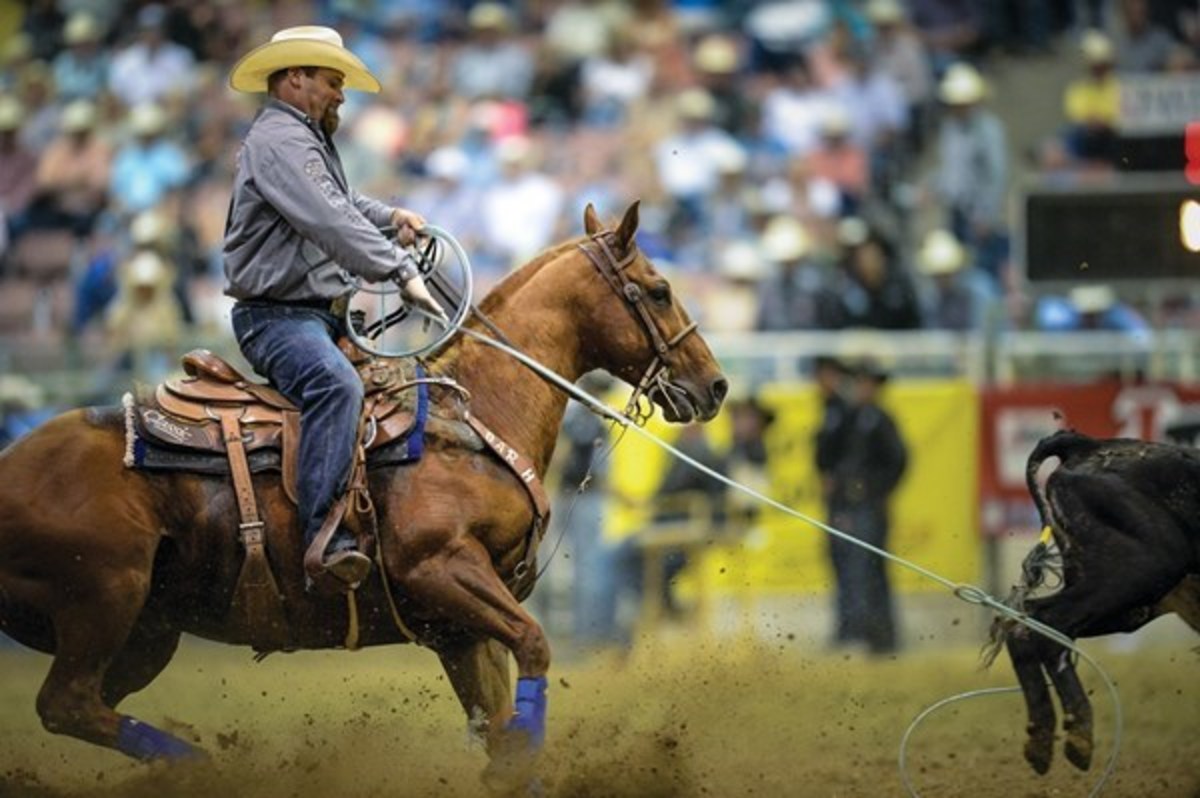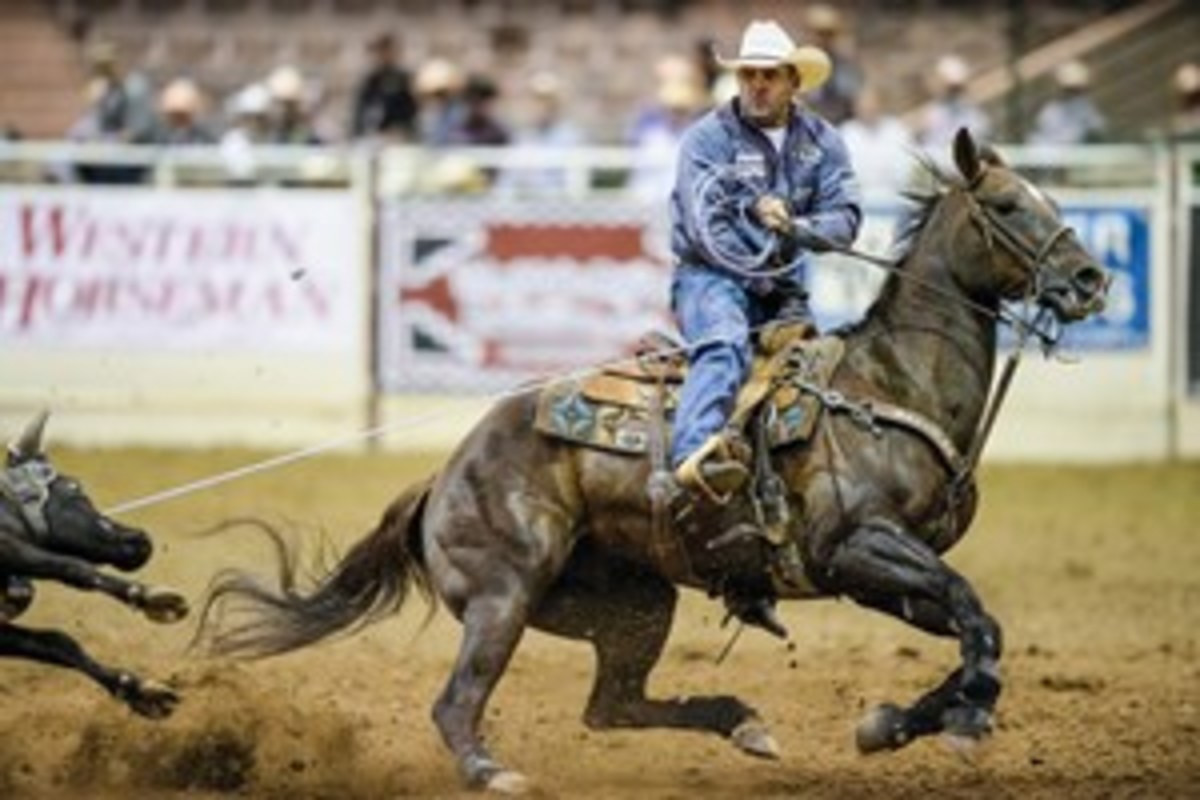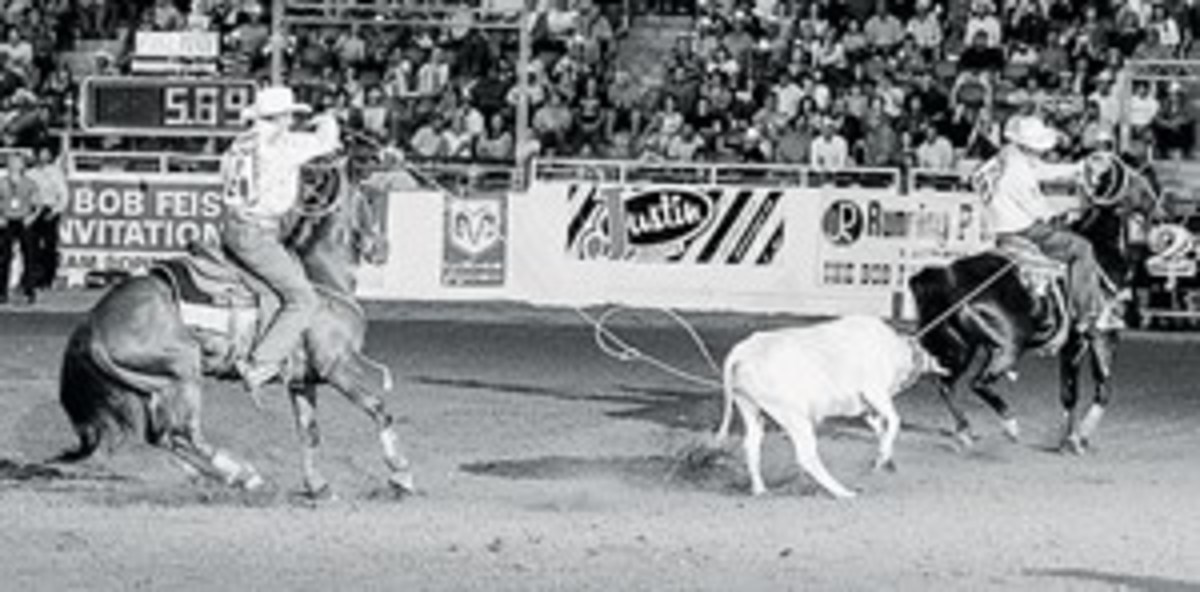
Ryan Motes’ Starbucks photo by Lone Wolf Photography
While a BFI win is a big moment for any team roper’s career, the coveted Horse of the BFI bronze is perhaps an even bigger accolade for their mounts. The trophy goes to the standout head and heel horse of the roping. It’s been a breakout moment for some, like Derrick Begay’s Swagger and Brandon Beers’ Jewel. For others, like Ryan Motes’ Starbucks and Travis Graves’ Superstar, the Horse of the BFI is a confirmation of what the sport’s greatest have known for years. We caught up with the cowboys who rode these great animals to find out what set their horses apart.
CD Starbucks – STARBUCKS – Ryan Motes, 2009, 2014
The BFI is a great set up for three-time WNFR-qualifying-heeler Ryan Motes, and horses has sure had a lot to do with it if you ask the Weatherford, Texas, cowboy. His great gelding, CD Starbucks, has taken home the Heel Horse of the BFI honors not once but twice, and the sorrel cutting-bred horse also claimed the AQHA/PRCA Heel Horse of the Year honor in 2013.
Motes’ mother raised Starbucks, who is out of a mare the family owns called Cari Me Starlight and by the 1994 NCHA Horse of the Year, CD Olena, shown by Motes’ step father, Winston Hansma. CD Olena won the NCHA Futurity, and when they started Starbucks, they thought the gelding could win in either the cutting or roping pen.
“I got him as a late 2-year-old, and he’s good at whatever you want to do,” Motes said. “He could have gone either way, but we decided to rope on him.”
Starbucks won his first Heel Horse of the BFI award in 2009 at age 11, after he was already well known throughout the industry as one of the greats. Motes won the BFI with Caleb Mitchell that year and earned a cool $74,705.
He spent the next few years on the rodeo road and took Motes back to the WNFR in 2012 and 2013, and he won his next Horse of the BFI award last year. Motes placed second in 2014 with Aaron Tsinigine and pocketed another $42,000.
“That roping is tough and the steers are fresh,” Motes said. “There’s no heel barrier but if you haze it’s terrible. The heel box is shorter than the head box so you need a horse that scores pretty good. If you’re on something slow it’s hard to get caught up to be consistent enough. The timing of the roping is in a funny spot, we’ve been at home practicing and rodeoing quite a bit, so to go from rodeoing into a jackpot, it’s hard to have a horse that’s good for both scenarios. There’s a lot of good horses there, but he runs hard and he times a steer really well. I’m rolling down the arena pretty hard and when we switch he reads them perfectly. It makes it a lot easier for me to focus on my roping. I’m able to just ride him around there. He’s helped my career, everything big I’ve ever won, I’ve won on him. I’ve won at least $120,000 on him at the BFI alone.”
ALICE – Adam Rose, 2014

Willard, Missourian, Adam Rose, never sent in the papers for his now 12-year-old gelding, Alice. The horse came out of Aliceville, Ala., and Rose, who always likes to name his horses after where they came from just shortened it to Alice.
“I’ve had him since he was a yearling,” Rose said. “I broke him to ride and day worked and ranched on him until he was 3. I sold my good horse when he was 5 and he’s been my main horse ever since.”
Rose had ridden the high-strung, but gentle horse in the Reno Livestock Events Center a handful of times before winning the Head Horse of the BFI in 2014 roping with partner, Billie Jack Saebens. The duo finished 11th in the average to collect $7,000.
“It’s hard to describe,” Rose recalled. “It was shocking but very, very special.”
Alice’s first rodeo was Fort Smith, Ark., as a 5-year-old, and he’s been just about everywhere since then—most recently earning Rose $17,040, after finishing seventh at the 2015 George Strait Team Roping Classic with Byron Wilkerson.
“That’s the thing about him, I can ride him everywhere. I can ride him where a 4.0 wins the big money or I can ride him at Salinas or Pendleton,” Rose explained. “I didn’t put nails on him at Pendleton this year and a lot of guys couldn’t believe I’d ride him there and not do that. I know he’s going to stand up, I trust him that much.”
LUCYS FAST JEWEL – JEWEL – Brandon Beers, 2013
The team roping world was abuzz with talk of that crazy-fast mare Brandon Beers showed up with at the 2013 BFI. Beers had been pretty low-key in the previous few years, and when he showed up heading for Jim Ross Cooper at the Feist with Jewel, everything changed.
“That was one of the first big ropings I took her to. I took her the year before to the Strait, and she was 7 then,” Beers said. “But she really came into her prime that next year at the BFI. She scores so good. She can run faster than any head horse I’ve ever ridden, but she slows down even faster. She has an exhaust break like a Dodge truck. We did so good that year at all the jackpots because of that move she’s got.”
They won third at the BFI, then went on to win more than any other team over the Fourth of July run the next week. It would launch Beers and Cooper into back-to-back WNFR qualifications and years with six-figure earnings.
Jewel has been out with health issues since the BFI in 2014, but Beers hopes to have her back in time for her favorite roping, the BFI, again in 2015.
STARBERT J MAN – HAMMER – Justin Davis, 2010
Texas’ Justin Davis rodeoed on Starbert J Man (Hammer) in the Lone Star State for nearly 10 years before he ever drew national acclaim at the BFI in 2010.
“That was the first time I’d ever been to the BFI and the first time he’d ever been ridden at that big of a roping,” Davis said. “We ended up winning fourth in the average (me and Cole Davison). We placed in two or three of the rounds.”
Hammer, trained by Davis’ father, scored outstanding and ran hard, setting him apart from the rest of the pack that year. The horse originally came from the Fisher Ranch in eastern Oklahoma, and was started as a calf horse by Davis family friend, Gary Thornton.
“He was my first head horse. I was heeling when my dad got him, and that horse got me heading. The day before the BFI I helped Colby Lovell in the World’s Greatest Roper, and he won second. It was a pretty cool week for him. Everybody wanted to buy that horse the whole time I rode him all those years, and I didn’t leave Texas back then. Speed Williams tried to buy him, Tee Woolman tried to buy him when he was still rodeoing, I even had several bull doggers try to buy him because he is so fast and flat across the line. I still practice on him, and my 4-year-old rides him every day.”
STAR TIME DIABLO – SUPERSTAR – Travis Graves, 2008
Travis Graves’ Star Time Diablo, better known as Superstar, has long been one of rodeo’s elite heel horses. Now retired in Graves’ Morgan Mill, Texas pasture, the horse is responsible for over $100,000 in BFI earnings.
“He was so fast,” Graves said. “It was easy for him, he could get down the arena no matter what you drew. He was cowy, too. He knew where to go and you just had to give him his head. He was real free and forgiving. If that steer hit bad, he would stay with him.”
The bay was too big for a cutter, so Graves bought the horse from his cousin as a 3-year-old. At the time, Superstar hadn’t even been introduced to a rope. Little did Graves know he would eventually live up to his name.
“I won the US Finals, the Wildfire three times, and the BFI on him in 2012. He’s retired, and he’s 21 this year. He gets around good, the hauling got hard on him and standing in stalls got him sore. He’s gentle, and I think my kids will ride him some day. That’s what I’m hoping for.”
SWAGGER – Derrick Begay, 2009
Derrick Begay’s Swagger has become his signature horse after six trips the Wrangler National Finals Rodeo, and wins everywhere from Omaha to Cheyenne. But before all that, the unregistered sorrel was an up-and-comer who was named the 2009 Head Horse of the BFI.
“I don’t like to brag on how good he is, but then I don’t like to brag on any of my animals, my horses or my dogs, because it just seems like when I get to bragging on them, they don’t work,” Begay said. “In all reality, he’s a good horse, and he’s my favorite.”
Begay had ridden Swagger at his first WNFR in 2008 with then-partner Victor Aros, but the horse really started turning heads at the Feist.
“I got him from a good Indian friend of mine, he’s the one who owned and trained him. I think Swagger wasn’t really that smart by the time I took him to the BFI—I had just started rodeoing on him and getting him seasoned, and he was still just a horse that really didn’t know what was going on so he didn’t overthink it. At that time in his career, he was just listening to me and reacting. Some horses, when they get older and they’ve been around, they get to anticipating or getting smarter.”
JAWS – Patrick Smith, 2005

Patrick Smith’s Jaws’ career was cut painfully short by injury, but he left his mark on Smith and the BFI in just one appearance in the Reno Livestock Events Center.
“He was really just getting started,” Smith said of the horse he won the world title on later that year. “That’s a horse that was retired way too soon. I had to quit riding him at 11 years old because he had a bad stifle injury. He’s one of the greatest of all time. Even when I didn’t know anything, he had a special way of being in the right place at the right time. That year, Clay Tryan (Smith’s partner in 2005) had Thumper and I had Jaws and we had one of the best years of either one of our careers. There was just something about that year—it was hard to do anything wrong, and the reason for it was those horses.”
They won the tour finale at Reno, won the BFI the next day, and went on to win the most money over the Fourth of July the next two weeks.
“It was unbelievable. Jaws wasn’t the fastest horse, but he always knew where he needed to be at the right time. In ’05, he would have been 10. I won the world on him that year, and in ’06, I had to get off of him. I had to put him down in 2010, and he wasn’t that old, but it was an injury that would never go away. He had no more cartilage in his left hind stifle. He’s buried under the oak tree at my house. He didn’t have papers, but I truly believe he would have won the PRCA/AQHA Heel Horse of the Year if he did. He was talented, but an outlaw. If you put him near anything else, he’d chase them down and bite them, and he wouldn’t let go. To this day, that was the greatest dollar-for-dollar purchase I’ve ever made—I paid $6,000 for him. I headed and heeled on him and practiced and rodeoed on him, because he’s all I had. If I showed up to rope, I was with Jaws.”
CATHEYS DIVIDEND – Buster – JD Yates, 2005
COLONEL CAL BAR – A – Jay Wadhams, 2010 (Owned by JD Yates)
The 18-foot head start that steers get at the BFI means horses comes into play more than nearly any other jackpot in the country, so, of course, one of team roping’s greatest horseman has two great horses on this list.
Pueblo, Colorado’s J.D. Yates owns both a head and heel horse that have won the Horse of the BFI Award. Yates won the prestigious award riding Catheys Dividend (Buster) in 2005, while his cousin, Jay Wadhams, rode Colonel Cal Bar (A) to the Horse of the BFI win in 2010.
“I bought Buster as a 3-year-old in Oklahoma and I gave him to my father (NFR qualifier Dick Yates) for Father’s Day,” Yates remembered. “He scored so good that it was unbelievable. And he could run. He will stand flat-footed in the box and never take anything away from you.”
Buster’s first appearance at the BFI was in 2001, and Yates won the first round and placed third in the average. The Reno Livestock Events Center has seemingly always been one of the gelding’s favorite places to spin steers.
“In 2005, after the first few steers we were at the top, and we made a real good run in the finals,” Yates remembered. “The steer went off to the left and that horse blew right up there, and our fastest run of the day was in the finals. That horse has been a freak of nature. I won the BFI and the National Finals Steer Roping on him in Hobbs, N.M., and my son (Trey) and I placed fifth in the average on him at the BFI in 2014. I rode him last year heading for my son, and we placed real good in Cheyenne in the team roping. I only ride him three places a year: the George Strait, the BFI and Cheyenne.”
Yates and Wadhams won the BFI in 2010 aboard both Buster and A, a dream team of horses in that set up.
“I think A is 17 now. I bought him quite a few years ago, and Jay rides him when he ropes for me at the horse shows,” Yates said. “Anytime Jay enters a rodeo he takes him and rides him. I had a heel horse, but between my son and my cousin, I never got to ride him. Last year Trey took him to the college finals and won a round on him. He stands around and they keep him in shape, and when somebody wants to, they go win on him.” TRJ











